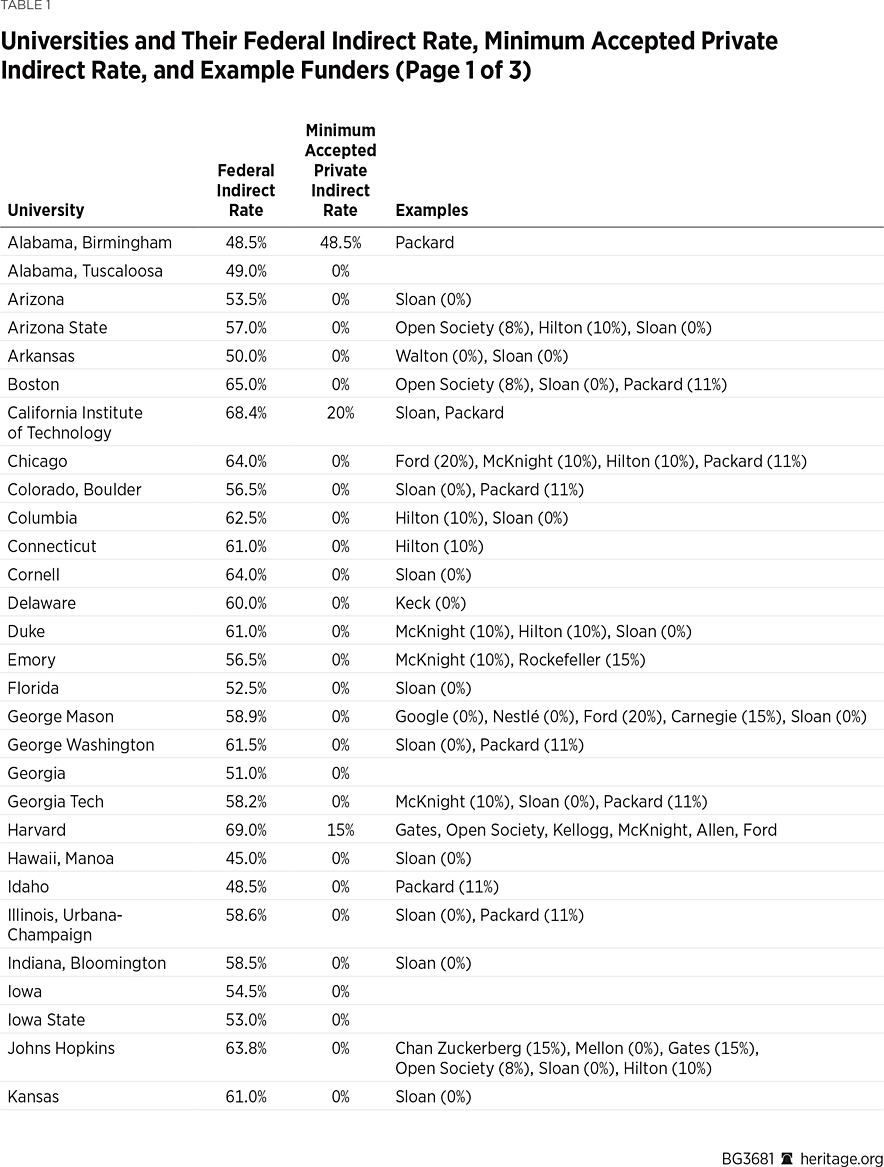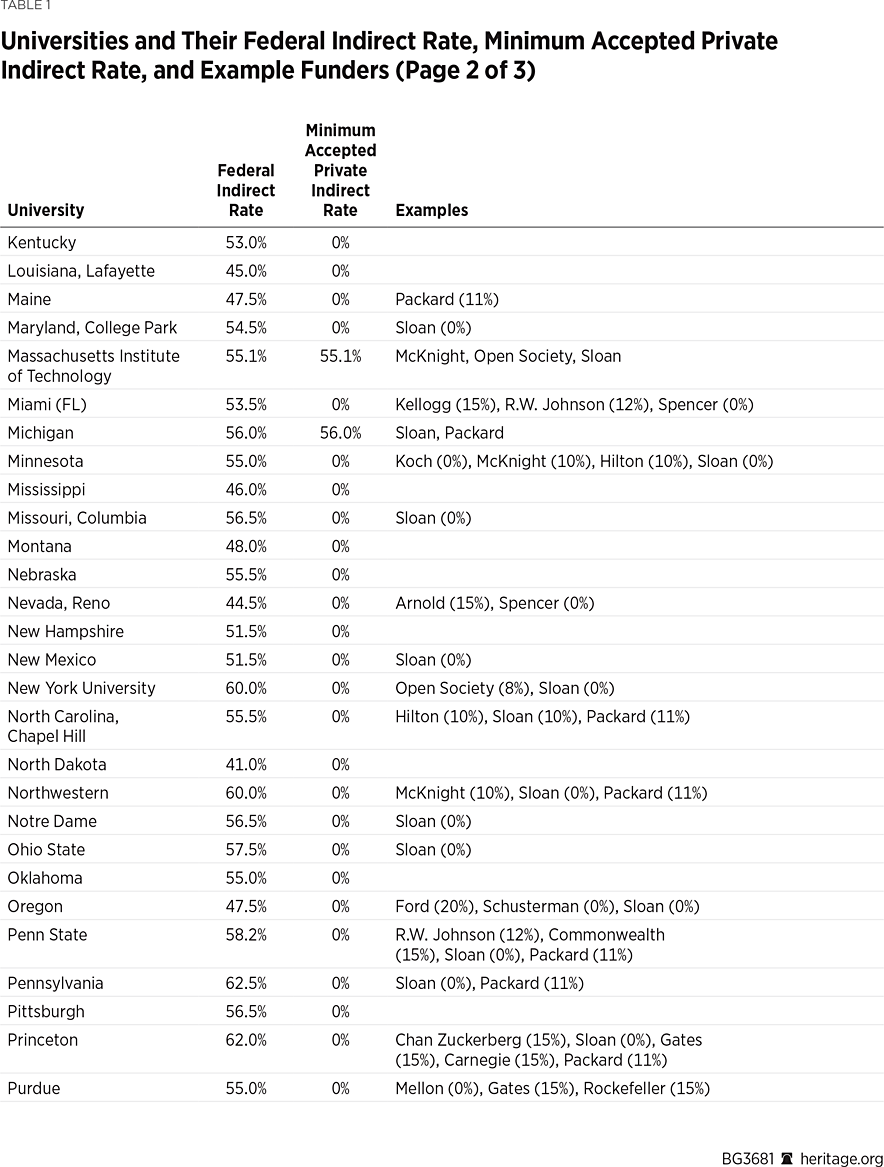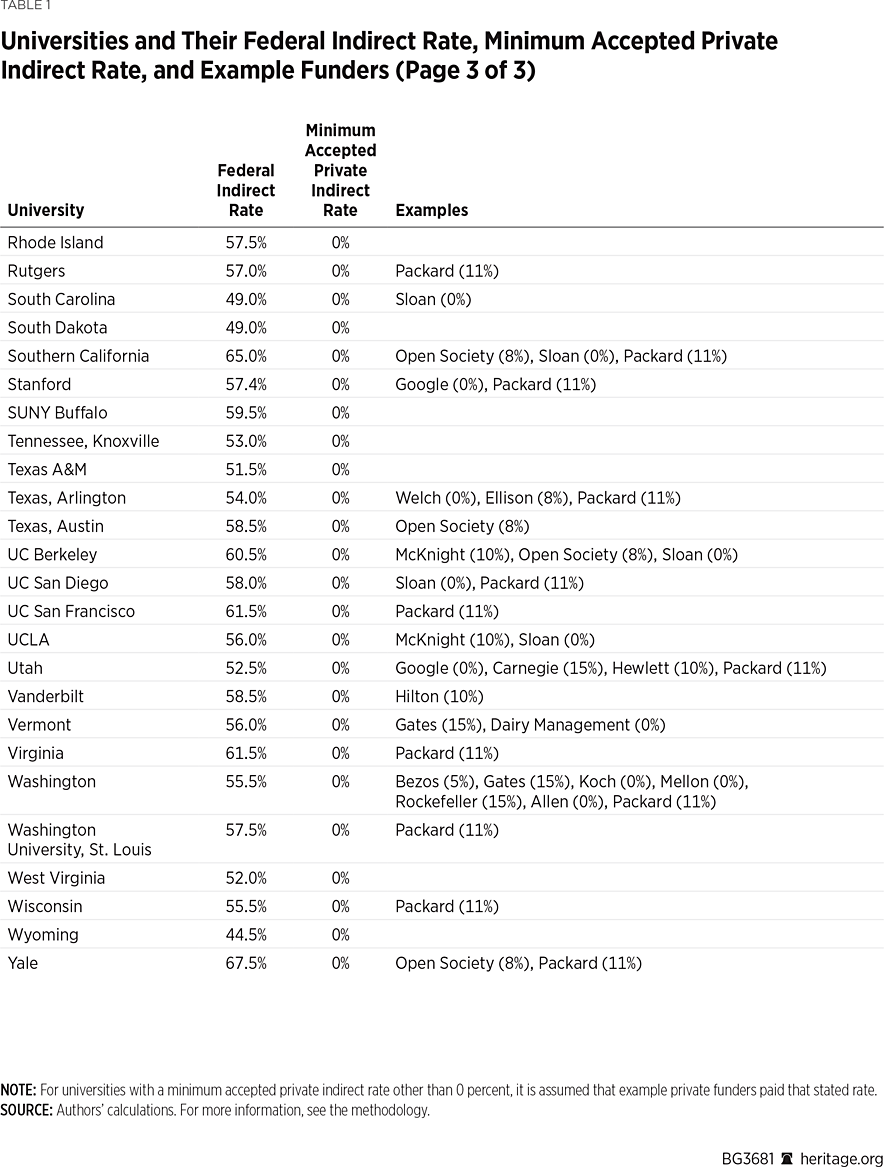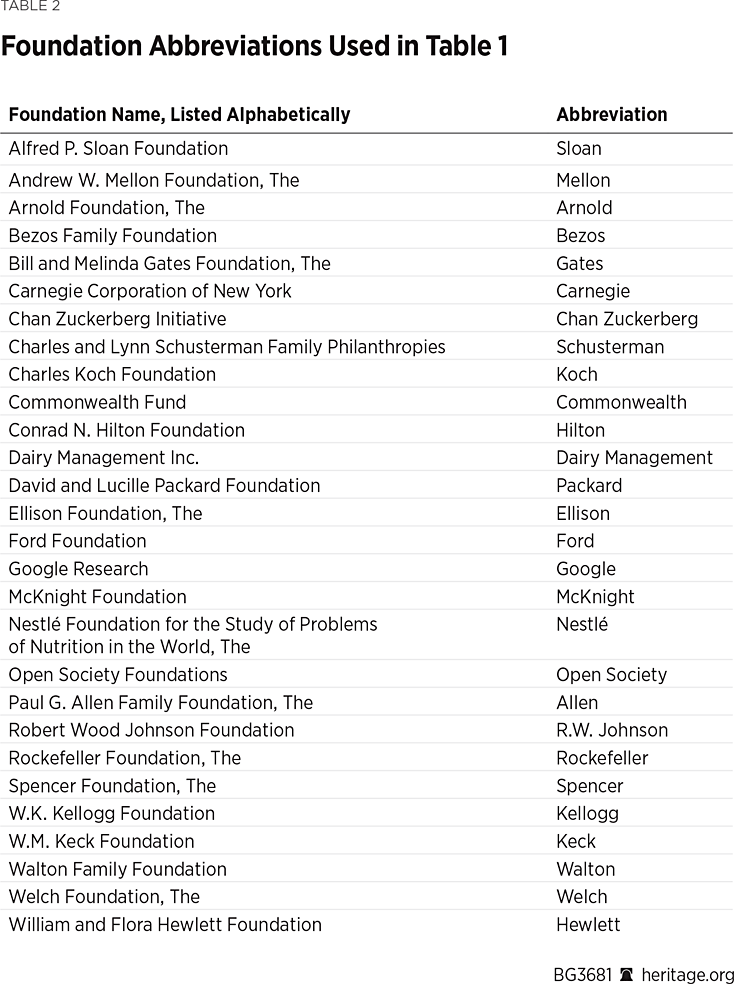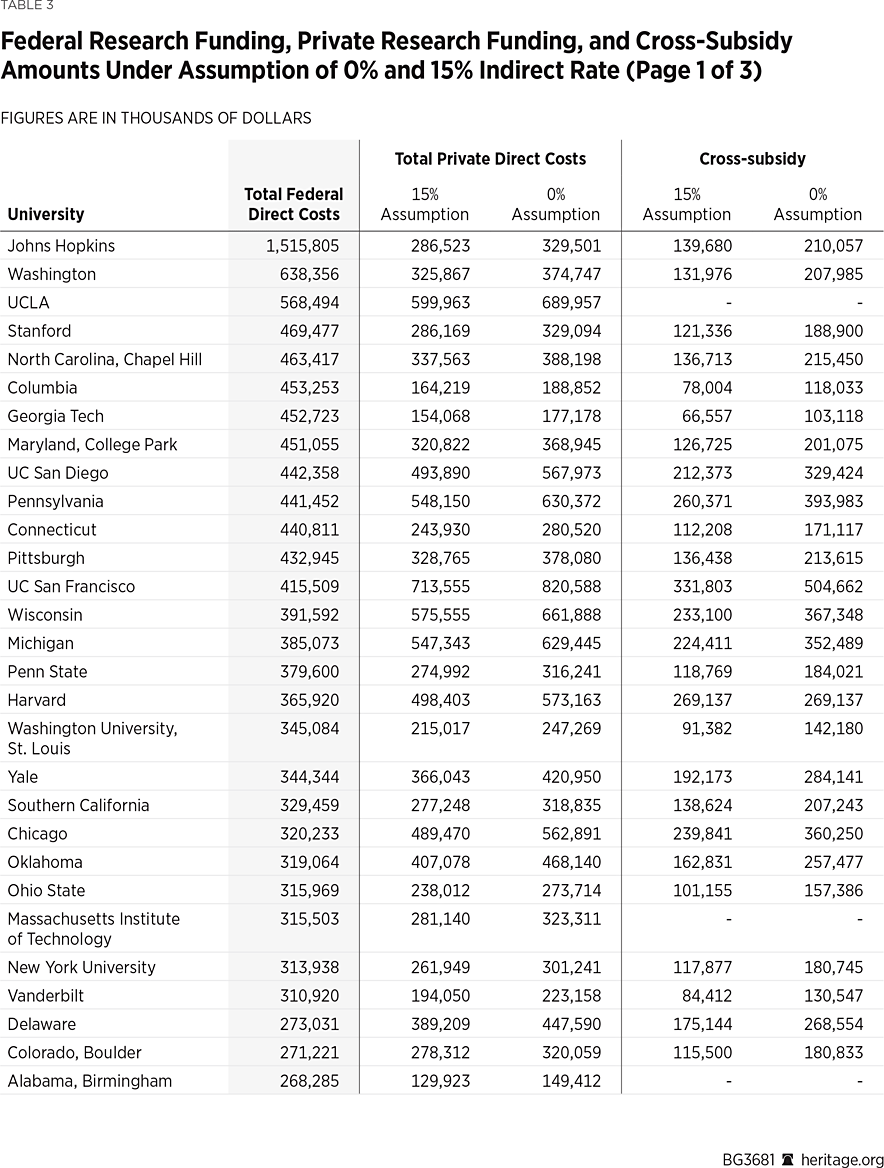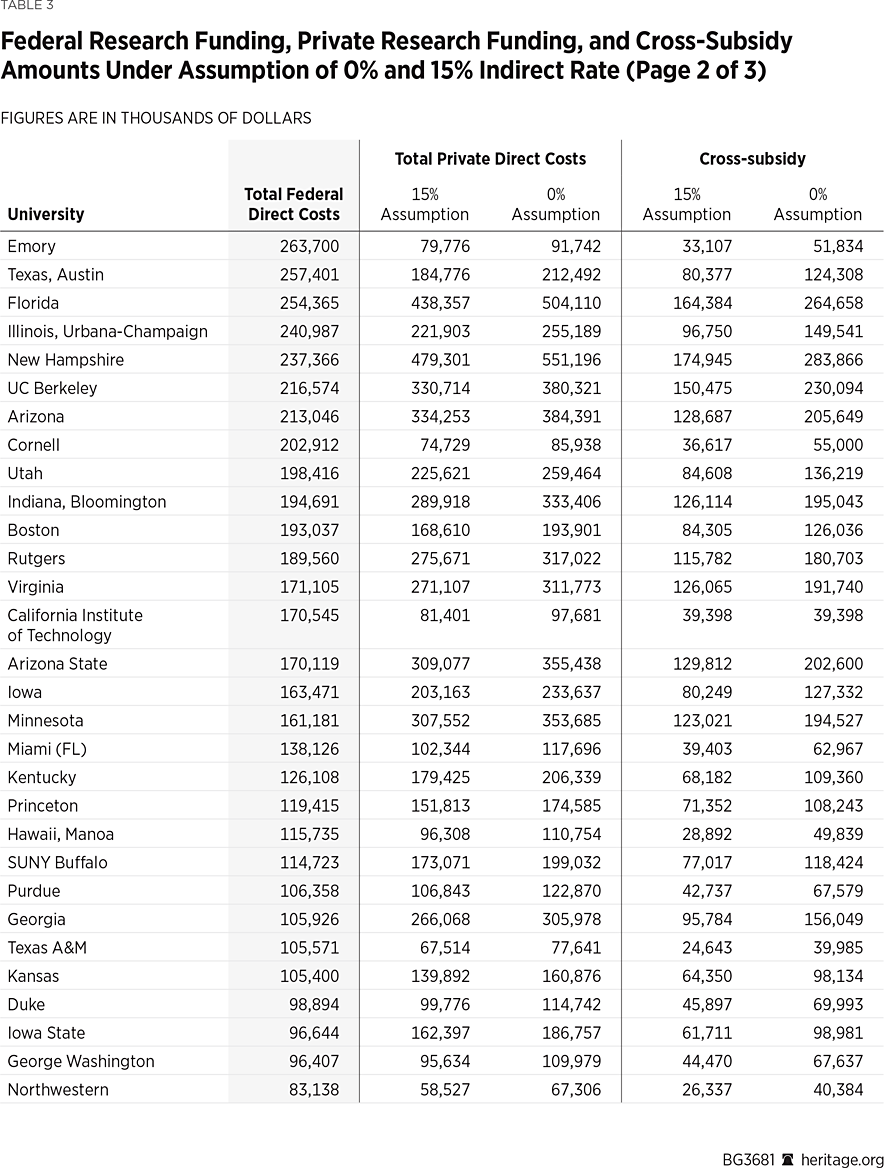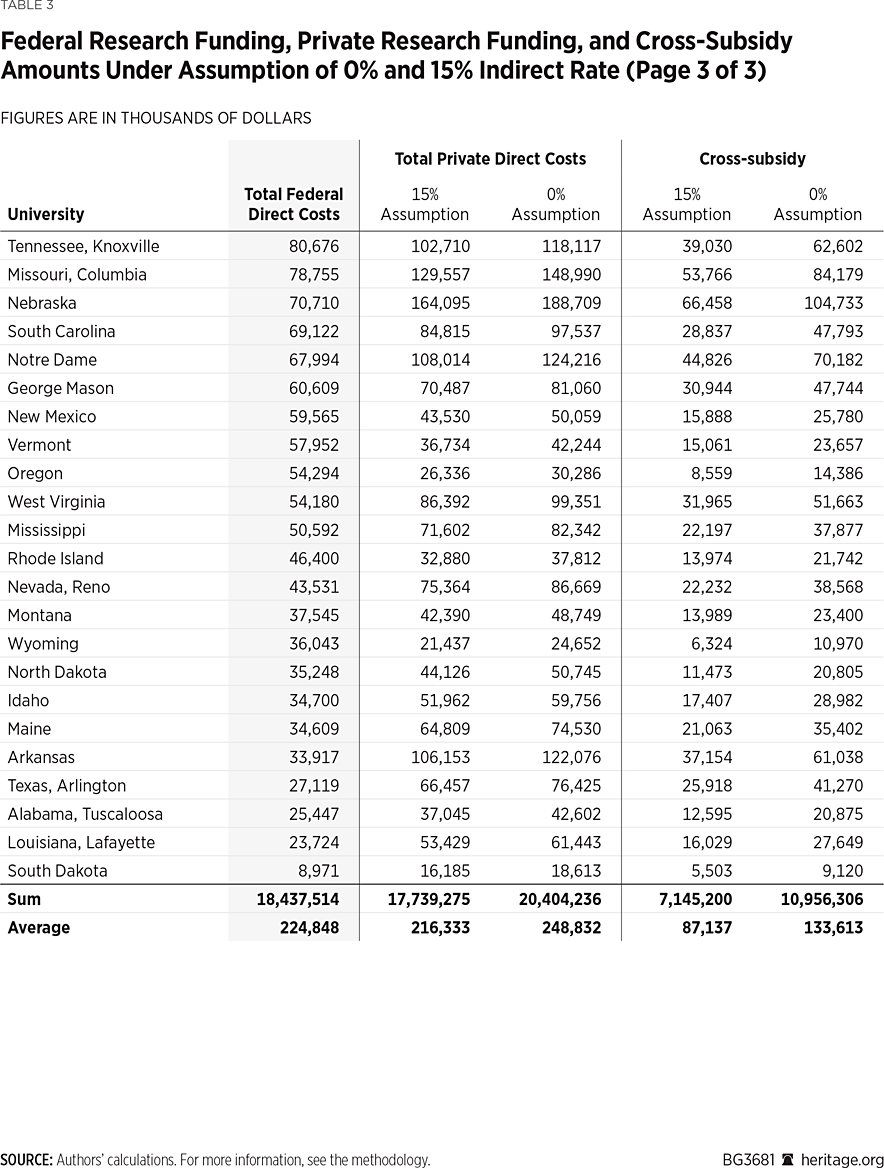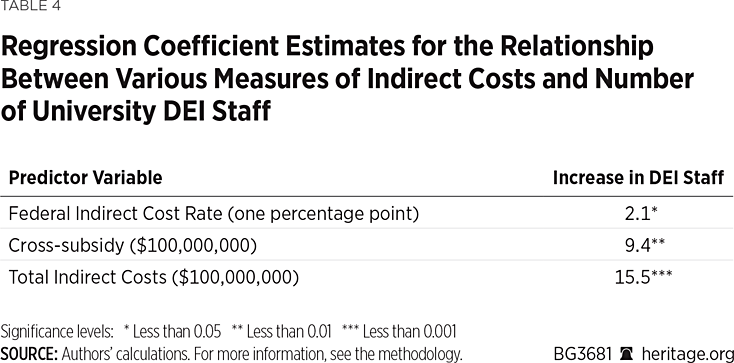Federal taxpayers began subsidizing scientific research at institutions of higher education in 1946.REF Now, thousands of university researchers submit proposals for federal grants to fund their research projects each year as part of the U.S. government’s decentralized system of contracted research.REF In 2019, universities received over $83 billion in research funding—$44 billion of which came from the pockets of taxpayers through grants awarded by federal agencies such as the National Institutes of Health and the National Science Foundation.REF Other organizations, such as nonprofit foundations, also fund academic research, and over time the share of funding contributed by such non-federal sources has become a substantial portion of total research funding.REF
The cost of all academic research projects includes the direct costs of the project, as well as overhead expenses, also known as indirect costs. The goal of this report is to quantify the extent to which the current system of indirect cost reimbursement of federal research grants subsidizes the agenda of the political left. The current system forces taxpayers to subsidize the Left in two concrete ways.
- In a clear example of crony capitalism, taxpayers cross-subsidize the research agendas of billionaire philanthropists and their organizations, such as Google Research and the Ford Foundation, many of which are captured by the political left.
- Universities use taxpayer dollars to pay for Diversity, Equity, and Inclusion (DEI) activity and the Left’s political agenda on campuses, not important scientific research.
A solution to these problems is for Congress to cap the indirect rate federal agencies pay for research overhead so that it does not exceed the lowest rate that a university accepts from a private organization. This market mechanism will force all funders to pay the true indirect cost rate, thereby eliminating the taxpayer cross-subsidy of private organizations and reducing the ability of universities to fund ideological and illiberal activity on campus.
Direct and Indirect Costs
Research grants fund two main components of research: direct costs and indirect costs. Direct costs are costs that can be directly accounted for in a research project such as researcher salaries and benefits, lab equipment, and animal specimens.REF Indirect costs, also known as facilities and administrative costs, are fixed overhead costs that are necessary for all activities that occur at a university but cannot be directly attributed to any specific research project. Indirect costs include expenses like building maintenance and operation, utilities, general office equipment, and administrative assistance.REF
Anticipated direct costs are identified through a system of cost accounting by the principal investigator in the grant proposal process and are considered when the awarding federal agency decides which researcher or research project is worthy of a grant.REF The researcher must itemize and spend the money allocated for direct costs in the specific time window detailed in the grant.
By contrast, the true indirect cost of a project is impossible to itemize. Currently, universities are reimbursed for indirect costs of federally funded research projects based on an indirect cost rate. The indirect cost rate is defined as a percentage of the direct costs of a research project that the funder pays the university in addition to the direct costs. For example, if the federal government awarded a grant of $100,000 with an indirect cost rate of 50 percent to University A, then the federal government would pay a total of $150,000.
This rate is negotiated between a major funder, for example, the Department of Health and Human Services or the Office of Naval Research, and each university.REF However, the negotiated rates are based on an arbitrary cost formula that provides a “patina of objectivity and technical respectability.”REF Cost experts carry out the façade of precision with expensive costing studies of historical overhead expenses at every university every few years to determine the projected indirect costs and the rate needed to cover them.REF And if, for some reason, a university receives less than the negotiated rate in a particular year, the difference is added to the next fiscal year, increasing the future rate.
Shortly after the federal government started funding academic research, it reimbursed indirect costs with a universal cap on the rate. The cap was first set at 8 percent, then after a few years increased to 15 percent, then to 20 percent.REF In 1966, the cap was removed and the indirect rate that taxpayers paid universities skyrocketed.REF By 1990, Stanford University had an indirect cost rate of 70 percent.REF After a handful of scandalous stories of universities using indirect cost funds to pay for yachts and decorations in the president’s house, indirect cost rates came down slightly. Today, however, indirect cost rates are again on the rise—and are a massive cost to taxpayers.
Problems With the Current System
There are at least two major problems with the current system of awarding federal research grants.
Subsidizing Billionaires. First, federal taxpayers cross-subsidize the overhead costs of the foundations of billionaire philanthropists. Taxpayers help fund the research agendas of foundations such as The Bill and Melinda Gates Foundation, the Ford Foundation, and George Soros’ Open Society Foundation. This is overt crony capitalism in that it is a transfer of money from taxpayers of modest means to very wealthy foundations backed by corporate interests.
Rarely do foundations reimburse university overhead costs at a rate of more than 15 percent, while most foundations pay zero percent (or no overhead) for research expenses.REF Taxpayers reimburse the same universities at rates over 60 percent. There exists a real overhead cost to academic research. However, it is not zero percent, and it is not 64 percent (the federal rate paid to Johns Hopkins University).REF
Funding Ideological Agendas. Second, fueled by a lack of transparency, indirect cost funds have likely contributed to the explosion of DEI staff on campuses across the nation.REF Essentially, indirect funds are unencumbered “profits” that administrators can direct for whatever purposes they prefer. As auditors have cracked down on obviously superfluous expenses such as yachts, one of the main things that administrators could choose to do with the profits from indirect rates is to hire more DEI staff.
According to a 2021 report, universities in the Power Five athletic conferences have an average of 45 DEI staff members.REF There is no evidence that DEI staff improve educational or research outcomes: In fact, there is evidence at the K–12 level that public school districts that have a DEI leadership position, such as a Chief Diversity Officer, saw their achievement gaps grow larger from 2009–2018.REF Other research shows that not only do DEI staff on college campuses not achieve their stated purpose of increasing inclusion of minority students on campus, but there is strong evidence of antisemitic attitudes among DEI staff.REF The authors of the study conclude that “it is clear that DEI staff at universities actually function as political activists, articulating and enforcing a narrow and radical ideological agenda.”REF
GAO Findings. One telling sign that there are problems with the current system of indirect cost reimbursement is that schools that receive more federal research funding also receive higher indirect cost rates. One would expect universities that receive more federal funding to need a lower indirect cost rate to cover fixed costs due to an economy of scale. A 2017 General Accounting Office (GAO) report found that nonprofit research institutes that receive federal funding are reimbursed at lower indirect cost rates than universities, suggesting that it is possible to conduct high quality research at lower costs.REF
There is very little research in the academic literature on these difficulties with the current system of indirect cost reimbursement. Understandably, academic researchers have no incentive to blow the whistle on their own livelihood. As a result, virtually no papers take the current system head on.REF There have been government-led reports on this issue over the years, mirroring the ebbs and flows of outrage sparked by egregious stories. However, substantive reform has never followed.
Methods
Data. The dataset used in this report is a convenience sample of 82 universities that includes the 35 schools that received the most federal research funds in fiscal year 2019, as well as the main public university in each state. For each university in the dataset, we collected federal indirect rates from the most recent indirect cost rate agreements which are publicly available on university websites. We also collected information on universities’ indirect rate policies for non-federal funding sources and the minimum rate that universities would accept from such sources.
We merged data from the 2019 Higher Education Research and Development Survey, a nationally representative survey of all institutions of higher education conducted by National Center for Science and Engineering Statistics within the National Science Foundation.REF These data show research expenditure data by source of funding (federal government, state and local government, university funds, business, nonprofit organizations, and all other sources) for all institutions of higher education that report spending at least $150,000 in fiscal year 2019.
To conduct regression analyses, we then merged the dataset from Diversity University.REF These data included the number of employees in roles dedicated to diversity, equity, and inclusion for all schools in the Power Five athletic conferences.
Assumptions and Justification. We analyzed nonprofit foundations that are the largest funders of academic research and their published indirect cost rates. The modal rate published by foundations is zero percent, and the maximum indirect cost rate that a foundation is willing to pay for an academic research project is 15 percent (e.g., Bill and Melinda Gates Foundation and John Templeton Foundation).
It is not possible to determine the exact amount that each organization funded each university due to data constraints. Therefore, we calculated estimates under two assumptions to represent the minimum and maximum estimated cross-subsidy amounts.
- To estimate the minimum likely cross-subsidy, we applied an indirect rate of 15 percent to all private funding sources that do not explicitly state a minimum acceptable rate.
- To estimate the maximum likely cross-subsidy amount, we repeated the calculation assuming an indirect cost rate of zero percent.
We removed the relatively small number of research grants from businesses from all calculations as universities are required to charge for-profit businesses the full federal rate. We calculated the total dollar amount that taxpayers cross-subsidize the research agendas of private organizations under those two situations and the average cross-subsidy per university under both assumptions.
Statistical Analysis. To test for a relationship between indirect costs and the number of university DEI staff, we fit three ordinary least squares regression models. We separately tested the federal indirect cost rate, total indirect reimbursement dollars, and amount of cross-subsidy for an association with the number of DEI staff.
Results
Table 1 shows the 82 universities included in the sample as well as the federal indirect cost rate, the minimum accepted private indirect cost rate, and examples of private organizations that fund research at each university. The sample represents 63 percent of the total academic research funding in the U.S.
The average federal indirect cost rate, weighted by total federal funding, is 58.3 percent. Federal indirect cost rates range from 41 percent for the University of North Dakota to 69 percent for Harvard University. Universities that receive more research funding tend to have higher federal indirect cost rates. The 10 universities in our sample that received the largest sums of money from taxpayers have federal indirect cost rates above 55 percent, whereas eight of the bottom 10 universities have indirect cost rates below 50 percent. This is consistent with previous research.REF
The most common minimum acceptable indirect cost rate that universities would accept from private organizations is zero percent. It is the policy of 67 of the 82 schools to accept the sponsor’s published rate, which is zero percent. Harvard University and California Institute of Technology accept minimum rates of 15 percent and 20 percent, respectively. The University of Alabama at Birmingham, Massachusetts Institute for Technology, and the University of Michigan are the only three universities in the sample that explicitly state that they will not accept rates that are lower than the federally negotiated rate, no matter the source. The minimum accepted private rates of 10 schools in the sample could not be confirmed.
Crony Capitalism
Table 3 shows the sample universities by federal research funding, non-federal research funding, and the estimated dollar amount that taxpayers cross-subsidize private organizations under the assumption of a zero percent private indirect cost rate and a 15 percent private indirect cost rate.
Assuming a private indirect cost rate of zero, the total amount that taxpayers subsidized the research private organizations in 2019 was $10.9 billion according to our sample. This amounts to $133 million per university. Under the most conservative assumption, using a private indirect cost rate of 15 percent, researchers estimate a total of $7.1 billion and $87 million per university.
Assuming a private indirect cost rate of zero, the cross-subsidy amount ranges from $9.1 million at the University of South Dakota to $505 million at the University of California, San Francisco.
Treating these two assumptions as lower and upper bounds, we estimate that taxpayers subsidized the research interests of billionaire philanthropists somewhere between $7.1 billion and $10.9 billion in 2019. This money went to organizations created by Mark Zuckerberg (Chan Zuckerberg Initiative); Jeff Bezos (Bezos Family Foundation); George Soros (Open Society Foundation); and Bill Gates (Bill and Melinda Gates Foundation), among others.
Funding DEI
The large sums of indirect cost funds received by universities is also contributing to the massive growth in DEI staff. Table 4 shows the results of the regression analyses. All three models show a statistically significant positive association between indirect costs and DEI staff. We found that a $100 million increase in cross-subsidy of private indirect costs is associated with 9.4 additional DEI employees. A 1 percentage point increase in the federal indirect cost rate is associated with 2.1 additional employees. And a $100 million increase in the total amount of indirect costs received by a university is associated with 15.5 additional DEI employees.
As documented in Diversity University: DEI Bloat in the Academy, the average major university has 45 employees dedicated to DEI.REF Given that the average cross-subsidy per university exceeds $100 million, over one-quarter of DEI staff positions would not exist were it not for the cross-subsidy from taxpayers.
In 1991, Congress put into place a limit on general administrative spending after a scandalous incident in which it was uncovered that Stanford used federal indirect cost reimbursement funds to cover the depreciation of a yacht and flowers for the president’s house.REF This limit, which is still in place, caps the amount of the indirect cost rate that can be spent on general administrative activities at 26 percentage points. With federal indirect rates ranging from 41 percent to 69 percent, 26 percentage points can still account for over half of indirect cost funds.
Further, this limit only applies to general administrative activities that serve the entire university.REF There are no limits to the within-department administrative spending, which is where DEI activity also occurs. Many departments at major universities have their own swelling administrative staff, including DEI chairpersons and committees.REF
Policy Solution
Over the years, many have proposed alternative systems of indirect cost reimbursement for federally contracted research, the most common proposal being a reintroduction of the universal cap on the indirect cost rate that existed before 1966. President Donald Trump proposed a universal 10 percent cap in his 2018 budget proposal—but was ignored.
In 2017, there was a Joint Research and Technology Subcommittee and Oversight Subcommittee hearing on “Examining the Overhead Cost of Research” led by Representative Barbara Comstock (R–VA), in which Richard Vedder, Ohio University economist, proposed that the indirect cost rate be added as a component of the grant application process, just as direct costs are. Grant proposals that propose a lower rate for a similar research project would receive a higher rating and be more likely to receive funding.
The EU and Japan use a flat-rate policy for all institutions set at 25 percent and 30 percent, respectively.REF Instead of setting a flat rate that is likely to rise over time, we propose a market-based solution to the overpayment problem of indirect rates.
- Congress Should Inject a Market Mechanism into Indirect Payment Rates. Instead of a universal cap that will be driven up over time by those in political power, Congress should prohibit federal grant-awarding agencies from paying an indirect rate that is higher than the lowest rate that is accepted from private organizations, such as foundations and businesses. This would introduce a market mechanism driven by private foundations and for-profit businesses. Compared to federal bureaucrats, foundations and businesses currently have a stronger incentive to allocate their resources efficiently and fund successful projects, which in turn attract more donations or profits in the future. They also may have a greater interest in applied scientific discoveries that could directly benefit millions of people rather than theoretical research.
- Congress Should Reduce Federal Research Grant Funding. Taxpayers are overpaying for the level of scientific progress they receive, as much of the research output from the current system of federal grant funding is waste. Most academic researchers are incentivized to produce quantity over quality, and, as a result, they publish predictable papers answering questions of little importance to society.REF
- Further, so many research findings have been uncovered as being false that the situation has been dubbed the “reproducibility crisis.”REF The current system of federal government subsidization of research is a major cause of these problems.REF The private sector would more efficiently direct resources to fruitful and innovative projects with much less bureaucracy and waste. Congress should reduce federal research spending and taxes so that more money flows to organizations that compete in the marketplace of innovation—not the marketplace of writing grant applications.
Economic theory predicts that, through such a market-based approach, the rate that foundations and businesses would be willing to pay would likely increase until the marginal cost of a grant is just less than the expected value of the research output. Universities will be forced to spend indirect funds more responsibly and accept a rate that is just high enough to cover their most necessary overhead costs. This change would incentivize funders and universities to arrive at an equilibrium overhead reimbursement rate that, on average, will converge on the true cost.
Forcing universities to accept the same rate from taxpayers that is no higher than the lowest rate that is accepted from private organizations would eliminate the crony cross-subsidy from taxpayers to billionaires. No longer would taxpayers be forced to help pay for projects—such as one at Columbia University funded by the Ford Foundation with the purpose of building “resilient social justice movements through peer-to-peer support.”REF Nor will they help the Open Society Foundation (Soros) “support the Center for Antiracist Research at Boston University in its research towards addressing racial inequity and injustice.”REF To be clear, private organizations should be able to fund any research project they choose with money that is voluntarily donated to them: They should not, however, use taxpayer dollars to directly fund their agendas.
This proposal would also incentivize all universities to spend money more efficiently. In the 1980s, taxpayers were forced to pay for yachts and decorations; today it is small armies of DEI staff. This proposal would dramatically reduce the amount of money available to universities to spend on political activism which is inimical to the mission of higher education. While it is not possible to make causal inference with these analyses, and there is likely residual confounding, the results are highly suggestive and warrant further analysis of university spending.
Not only are the indirect costs of federal grants paying for DEI staff on campus, but the direct costs are paying for more DEI-driven research. A November 2021 report from the Center for the Study of Partisanship and Ideology found that “as of 2020, 30.4% of all grants had one of the following politicized terms: ‘equity,’ ‘diversity,’ ‘inclusion,’ ‘gender,’ ‘marginalize,’ ‘underrepresented,’ or ‘disparity.’ This is up from 2.9% in 1990.”REF The incidence of such terms varied by field, but even computer science and engineering saw an increase from 1.5 percent to 24.9 percent.
This proposal would also reduce the need for such a complex and expensive system of negotiations, audits, and accounting. In response to waves of dissatisfaction and controversy regarding university spending of indirect funds, government regulators intervened with stronger rules and guidance, predictably making things worse. The federal government introduced “110 new regulatory requirements upon research grant recipients between 1991 and 2018.” The administrative and compliance costs of such regulations are themselves reimbursed as indirect costs.REF This proposal would require a simple annual audit, and the expensive cost calculations would be eliminated.
Additionally, this would reduce the likelihood that taxpayers are exploited for extravagant and unnecessary spending such as the maintenance and depreciation of extremely expensive new buildings with elaborate designs and features.REF Currently, universities with wealthy donors can use gifts to build unnecessarily fancy research facilities, then ask for and receive much higher indirect rates to cover the facilities’ operation and maintenance.
Conclusion
Currently, taxpayers are forced to subsidize the agenda of the political left through funding its research agendas and DEI staff on university campuses. The Left has used the indirect cost reimbursement system to capture an important professional institution.
Federal grant-awarding agencies should not pay an indirect rate that is higher than the lowest rate that is accepted from private organizations, such as foundations and businesses. This would eliminate cross-subsidies and dramatically reduce universities’ ability to install more DEI staff. Universities must be held accountable, and the exploitation of taxpayers must end.
Jay P. Greene, PhD, is Senior Research Fellow in the Center for Education Policy, of the Institute for Family, Community, and Opportunity, at The Heritage Foundation. John Schoof is Research Associate in the Center for Education Policy.
